Impact of Business Intelligence and Analytics on Decision Making
VerifiedAdded on 2020/01/28
|12
|3561
|110
Report
AI Summary
This report delves into the significance of Business Intelligence (BI) and Business Analytics (BA) within the context of a Management Information System (MIS). It explores the core concepts of BI and BA, examining how these tools facilitate improved decision-making processes across various levels of an organization. The report outlines the different types of decisions made in a business environment (strategic, tactical, and operational) and how BI and BA support each. It then identifies the six elements of the BI environment and the five analytical outputs BI systems utilize. Furthermore, the report highlights the benefits of employing intelligent techniques in decision-making and knowledge management, including how these systems aid group decision-making and improve enterprise-wide knowledge management. The analysis underscores the crucial role of BI and BA in providing real-time information, supporting informed decisions, and fostering a competitive edge in today's dynamic business landscape. The report concludes by emphasizing the importance of integrating these technologies to enhance operational efficiency and strategic planning. This report is contributed by a student and available on Desklib, a platform that provides AI-based study tools.

MANAGEMENT
INFORMATION SYSTEM
INFORMATION SYSTEM
Paraphrase This Document
Need a fresh take? Get an instant paraphrase of this document with our AI Paraphraser
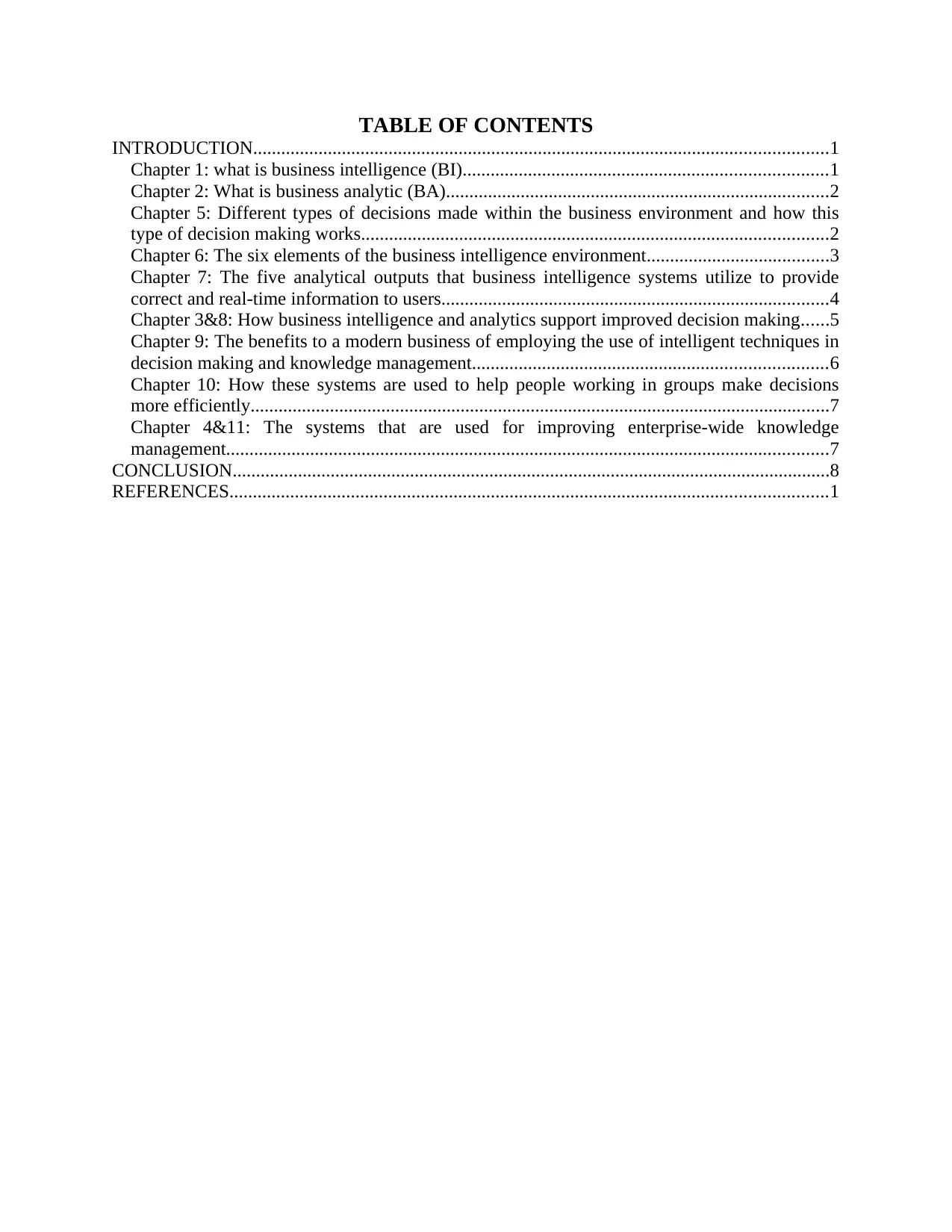
TABLE OF CONTENTS
INTRODUCTION...........................................................................................................................1
Chapter 1: what is business intelligence (BI)..............................................................................1
Chapter 2: What is business analytic (BA)..................................................................................2
Chapter 5: Different types of decisions made within the business environment and how this
type of decision making works....................................................................................................2
Chapter 6: The six elements of the business intelligence environment.......................................3
Chapter 7: The five analytical outputs that business intelligence systems utilize to provide
correct and real-time information to users...................................................................................4
Chapter 3&8: How business intelligence and analytics support improved decision making......5
Chapter 9: The benefits to a modern business of employing the use of intelligent techniques in
decision making and knowledge management............................................................................6
Chapter 10: How these systems are used to help people working in groups make decisions
more efficiently............................................................................................................................7
Chapter 4&11: The systems that are used for improving enterprise-wide knowledge
management.................................................................................................................................7
CONCLUSION................................................................................................................................8
REFERENCES................................................................................................................................1
INTRODUCTION...........................................................................................................................1
Chapter 1: what is business intelligence (BI)..............................................................................1
Chapter 2: What is business analytic (BA)..................................................................................2
Chapter 5: Different types of decisions made within the business environment and how this
type of decision making works....................................................................................................2
Chapter 6: The six elements of the business intelligence environment.......................................3
Chapter 7: The five analytical outputs that business intelligence systems utilize to provide
correct and real-time information to users...................................................................................4
Chapter 3&8: How business intelligence and analytics support improved decision making......5
Chapter 9: The benefits to a modern business of employing the use of intelligent techniques in
decision making and knowledge management............................................................................6
Chapter 10: How these systems are used to help people working in groups make decisions
more efficiently............................................................................................................................7
Chapter 4&11: The systems that are used for improving enterprise-wide knowledge
management.................................................................................................................................7
CONCLUSION................................................................................................................................8
REFERENCES................................................................................................................................1
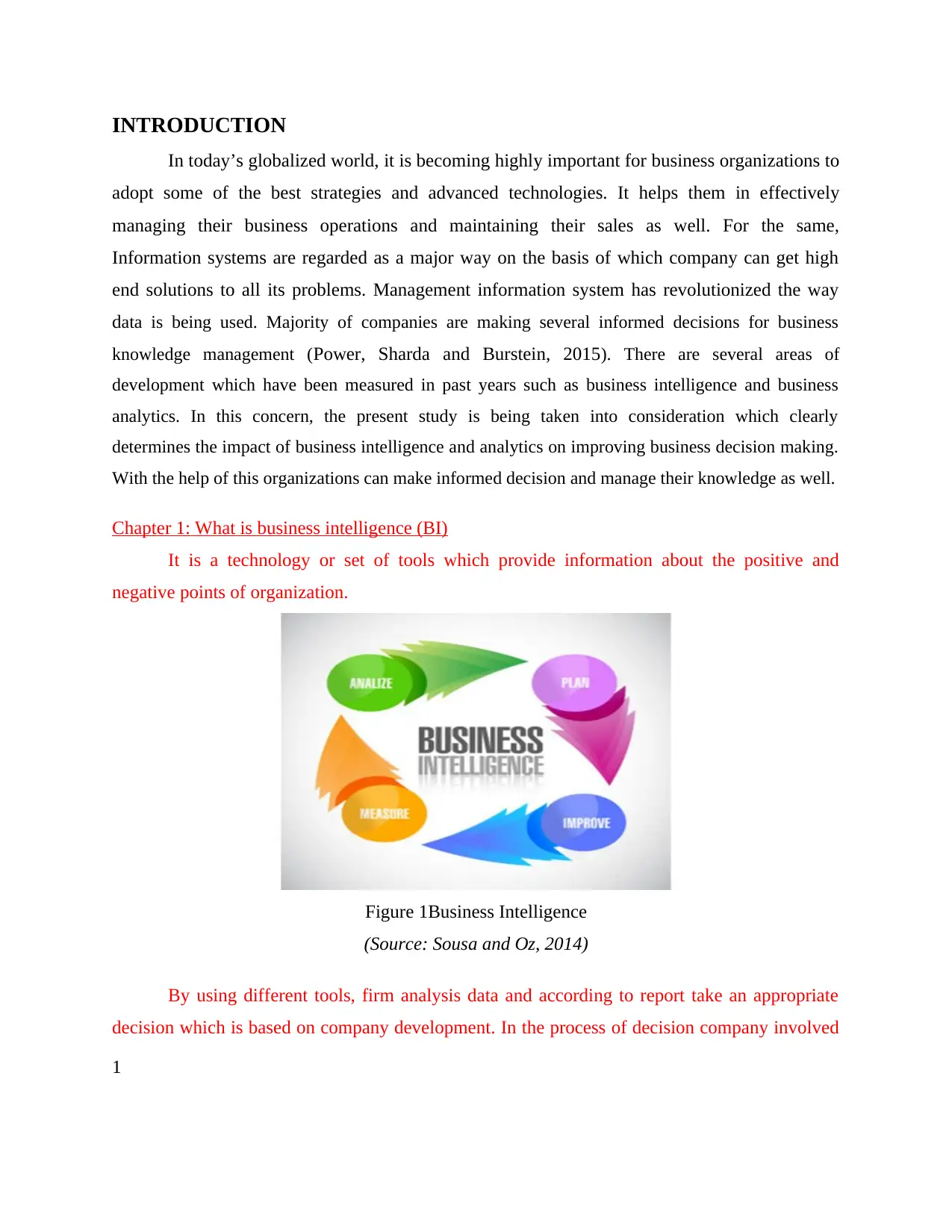
INTRODUCTION
In today’s globalized world, it is becoming highly important for business organizations to
adopt some of the best strategies and advanced technologies. It helps them in effectively
managing their business operations and maintaining their sales as well. For the same,
Information systems are regarded as a major way on the basis of which company can get high
end solutions to all its problems. Management information system has revolutionized the way
data is being used. Majority of companies are making several informed decisions for business
knowledge management (Power, Sharda and Burstein, 2015). There are several areas of
development which have been measured in past years such as business intelligence and business
analytics. In this concern, the present study is being taken into consideration which clearly
determines the impact of business intelligence and analytics on improving business decision making.
With the help of this organizations can make informed decision and manage their knowledge as well.
Chapter 1: What is business intelligence (BI)
It is a technology or set of tools which provide information about the positive and
negative points of organization.
Figure 1Business Intelligence
(Source: Sousa and Oz, 2014)
By using different tools, firm analysis data and according to report take an appropriate
decision which is based on company development. In the process of decision company involved
1
In today’s globalized world, it is becoming highly important for business organizations to
adopt some of the best strategies and advanced technologies. It helps them in effectively
managing their business operations and maintaining their sales as well. For the same,
Information systems are regarded as a major way on the basis of which company can get high
end solutions to all its problems. Management information system has revolutionized the way
data is being used. Majority of companies are making several informed decisions for business
knowledge management (Power, Sharda and Burstein, 2015). There are several areas of
development which have been measured in past years such as business intelligence and business
analytics. In this concern, the present study is being taken into consideration which clearly
determines the impact of business intelligence and analytics on improving business decision making.
With the help of this organizations can make informed decision and manage their knowledge as well.
Chapter 1: What is business intelligence (BI)
It is a technology or set of tools which provide information about the positive and
negative points of organization.
Figure 1Business Intelligence
(Source: Sousa and Oz, 2014)
By using different tools, firm analysis data and according to report take an appropriate
decision which is based on company development. In the process of decision company involved
1
⊘ This is a preview!⊘
Do you want full access?
Subscribe today to unlock all pages.

Trusted by 1+ million students worldwide
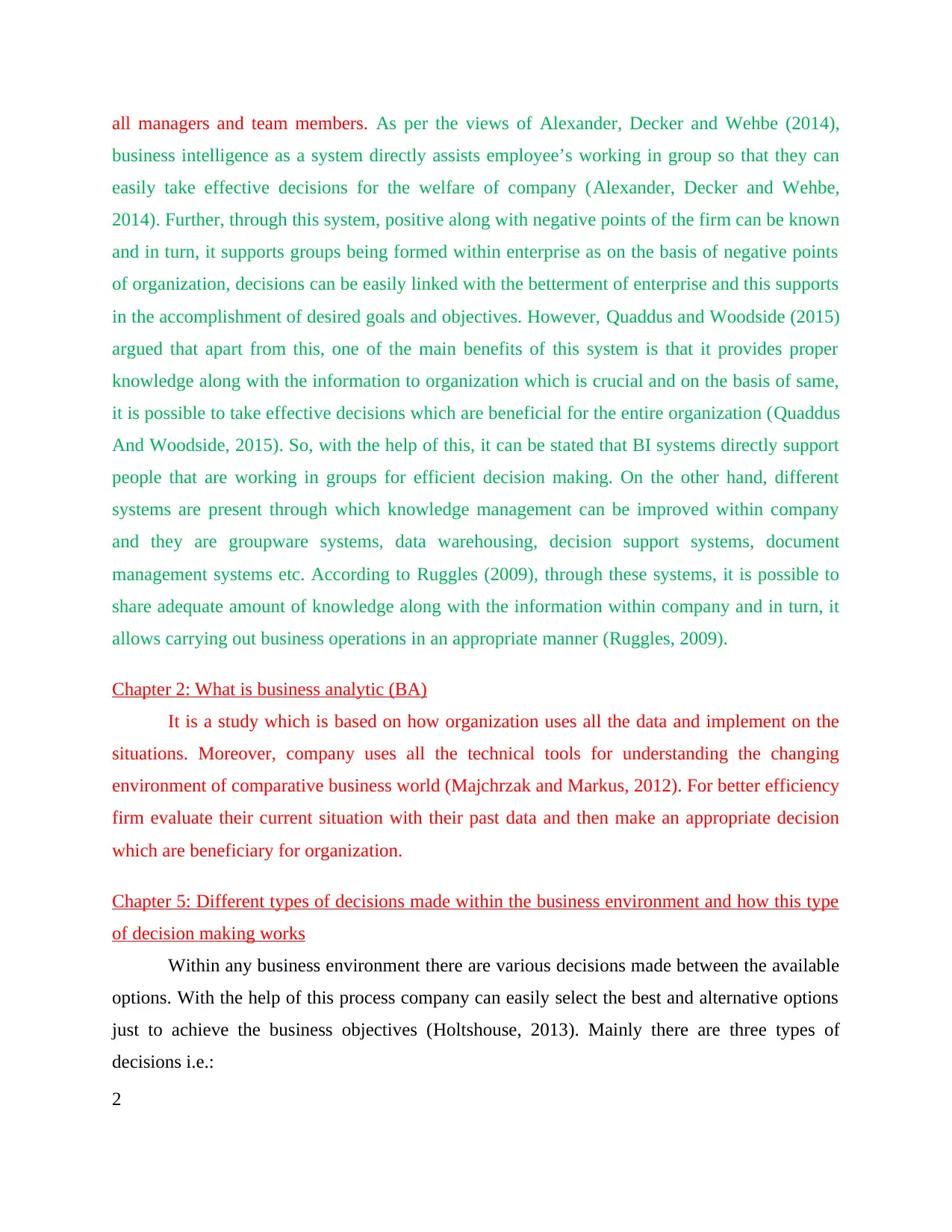
all managers and team members. As per the views of Alexander, Decker and Wehbe (2014),
business intelligence as a system directly assists employee’s working in group so that they can
easily take effective decisions for the welfare of company (Alexander, Decker and Wehbe,
2014). Further, through this system, positive along with negative points of the firm can be known
and in turn, it supports groups being formed within enterprise as on the basis of negative points
of organization, decisions can be easily linked with the betterment of enterprise and this supports
in the accomplishment of desired goals and objectives. However, Quaddus and Woodside (2015)
argued that apart from this, one of the main benefits of this system is that it provides proper
knowledge along with the information to organization which is crucial and on the basis of same,
it is possible to take effective decisions which are beneficial for the entire organization (Quaddus
And Woodside, 2015). So, with the help of this, it can be stated that BI systems directly support
people that are working in groups for efficient decision making. On the other hand, different
systems are present through which knowledge management can be improved within company
and they are groupware systems, data warehousing, decision support systems, document
management systems etc. According to Ruggles (2009), through these systems, it is possible to
share adequate amount of knowledge along with the information within company and in turn, it
allows carrying out business operations in an appropriate manner (Ruggles, 2009).
Chapter 2: What is business analytic (BA)
It is a study which is based on how organization uses all the data and implement on the
situations. Moreover, company uses all the technical tools for understanding the changing
environment of comparative business world (Majchrzak and Markus, 2012). For better efficiency
firm evaluate their current situation with their past data and then make an appropriate decision
which are beneficiary for organization.
Chapter 5: Different types of decisions made within the business environment and how this type
of decision making works
Within any business environment there are various decisions made between the available
options. With the help of this process company can easily select the best and alternative options
just to achieve the business objectives (Holtshouse, 2013). Mainly there are three types of
decisions i.e.:
2
business intelligence as a system directly assists employee’s working in group so that they can
easily take effective decisions for the welfare of company (Alexander, Decker and Wehbe,
2014). Further, through this system, positive along with negative points of the firm can be known
and in turn, it supports groups being formed within enterprise as on the basis of negative points
of organization, decisions can be easily linked with the betterment of enterprise and this supports
in the accomplishment of desired goals and objectives. However, Quaddus and Woodside (2015)
argued that apart from this, one of the main benefits of this system is that it provides proper
knowledge along with the information to organization which is crucial and on the basis of same,
it is possible to take effective decisions which are beneficial for the entire organization (Quaddus
And Woodside, 2015). So, with the help of this, it can be stated that BI systems directly support
people that are working in groups for efficient decision making. On the other hand, different
systems are present through which knowledge management can be improved within company
and they are groupware systems, data warehousing, decision support systems, document
management systems etc. According to Ruggles (2009), through these systems, it is possible to
share adequate amount of knowledge along with the information within company and in turn, it
allows carrying out business operations in an appropriate manner (Ruggles, 2009).
Chapter 2: What is business analytic (BA)
It is a study which is based on how organization uses all the data and implement on the
situations. Moreover, company uses all the technical tools for understanding the changing
environment of comparative business world (Majchrzak and Markus, 2012). For better efficiency
firm evaluate their current situation with their past data and then make an appropriate decision
which are beneficiary for organization.
Chapter 5: Different types of decisions made within the business environment and how this type
of decision making works
Within any business environment there are various decisions made between the available
options. With the help of this process company can easily select the best and alternative options
just to achieve the business objectives (Holtshouse, 2013). Mainly there are three types of
decisions i.e.:
2
Paraphrase This Document
Need a fresh take? Get an instant paraphrase of this document with our AI Paraphraser
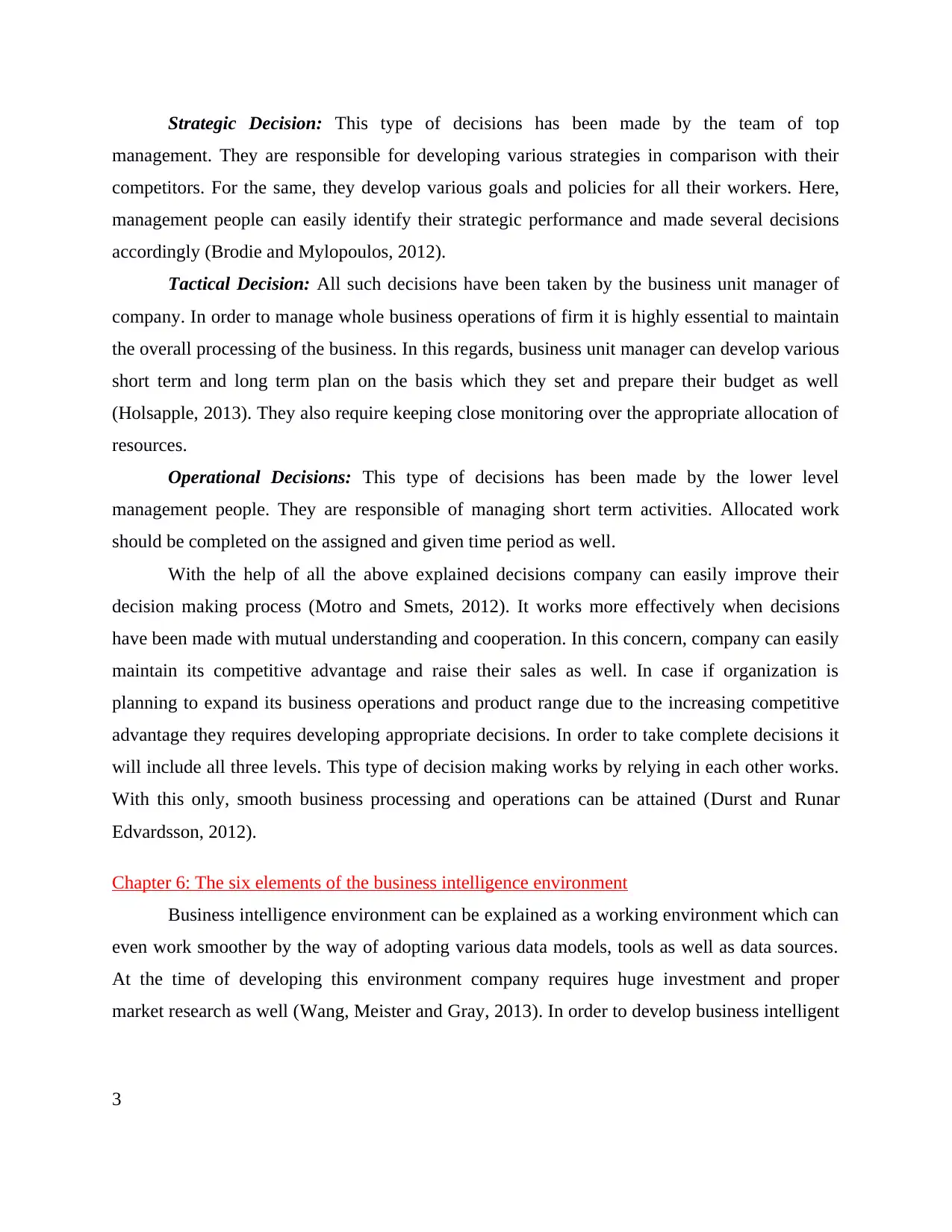
Strategic Decision: This type of decisions has been made by the team of top
management. They are responsible for developing various strategies in comparison with their
competitors. For the same, they develop various goals and policies for all their workers. Here,
management people can easily identify their strategic performance and made several decisions
accordingly (Brodie and Mylopoulos, 2012).
Tactical Decision: All such decisions have been taken by the business unit manager of
company. In order to manage whole business operations of firm it is highly essential to maintain
the overall processing of the business. In this regards, business unit manager can develop various
short term and long term plan on the basis which they set and prepare their budget as well
(Holsapple, 2013). They also require keeping close monitoring over the appropriate allocation of
resources.
Operational Decisions: This type of decisions has been made by the lower level
management people. They are responsible of managing short term activities. Allocated work
should be completed on the assigned and given time period as well.
With the help of all the above explained decisions company can easily improve their
decision making process (Motro and Smets, 2012). It works more effectively when decisions
have been made with mutual understanding and cooperation. In this concern, company can easily
maintain its competitive advantage and raise their sales as well. In case if organization is
planning to expand its business operations and product range due to the increasing competitive
advantage they requires developing appropriate decisions. In order to take complete decisions it
will include all three levels. This type of decision making works by relying in each other works.
With this only, smooth business processing and operations can be attained (Durst and Runar
Edvardsson, 2012).
Chapter 6: The six elements of the business intelligence environment
Business intelligence environment can be explained as a working environment which can
even work smoother by the way of adopting various data models, tools as well as data sources.
At the time of developing this environment company requires huge investment and proper
market research as well (Wang, Meister and Gray, 2013). In order to develop business intelligent
3
management. They are responsible for developing various strategies in comparison with their
competitors. For the same, they develop various goals and policies for all their workers. Here,
management people can easily identify their strategic performance and made several decisions
accordingly (Brodie and Mylopoulos, 2012).
Tactical Decision: All such decisions have been taken by the business unit manager of
company. In order to manage whole business operations of firm it is highly essential to maintain
the overall processing of the business. In this regards, business unit manager can develop various
short term and long term plan on the basis which they set and prepare their budget as well
(Holsapple, 2013). They also require keeping close monitoring over the appropriate allocation of
resources.
Operational Decisions: This type of decisions has been made by the lower level
management people. They are responsible of managing short term activities. Allocated work
should be completed on the assigned and given time period as well.
With the help of all the above explained decisions company can easily improve their
decision making process (Motro and Smets, 2012). It works more effectively when decisions
have been made with mutual understanding and cooperation. In this concern, company can easily
maintain its competitive advantage and raise their sales as well. In case if organization is
planning to expand its business operations and product range due to the increasing competitive
advantage they requires developing appropriate decisions. In order to take complete decisions it
will include all three levels. This type of decision making works by relying in each other works.
With this only, smooth business processing and operations can be attained (Durst and Runar
Edvardsson, 2012).
Chapter 6: The six elements of the business intelligence environment
Business intelligence environment can be explained as a working environment which can
even work smoother by the way of adopting various data models, tools as well as data sources.
At the time of developing this environment company requires huge investment and proper
market research as well (Wang, Meister and Gray, 2013). In order to develop business intelligent
3
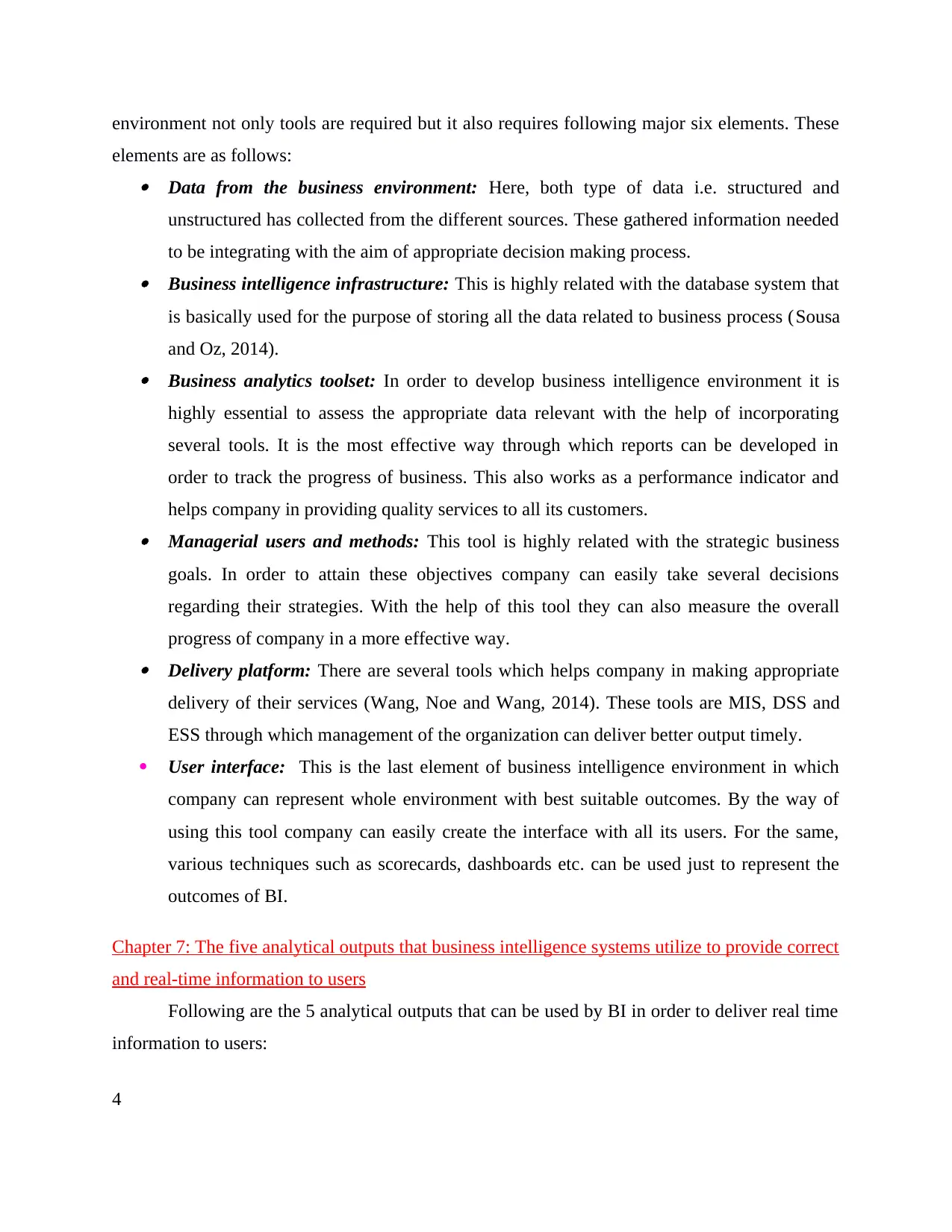
environment not only tools are required but it also requires following major six elements. These
elements are as follows: Data from the business environment: Here, both type of data i.e. structured and
unstructured has collected from the different sources. These gathered information needed
to be integrating with the aim of appropriate decision making process. Business intelligence infrastructure: This is highly related with the database system that
is basically used for the purpose of storing all the data related to business process (Sousa
and Oz, 2014). Business analytics toolset: In order to develop business intelligence environment it is
highly essential to assess the appropriate data relevant with the help of incorporating
several tools. It is the most effective way through which reports can be developed in
order to track the progress of business. This also works as a performance indicator and
helps company in providing quality services to all its customers. Managerial users and methods: This tool is highly related with the strategic business
goals. In order to attain these objectives company can easily take several decisions
regarding their strategies. With the help of this tool they can also measure the overall
progress of company in a more effective way. Delivery platform: There are several tools which helps company in making appropriate
delivery of their services (Wang, Noe and Wang, 2014). These tools are MIS, DSS and
ESS through which management of the organization can deliver better output timely.
User interface: This is the last element of business intelligence environment in which
company can represent whole environment with best suitable outcomes. By the way of
using this tool company can easily create the interface with all its users. For the same,
various techniques such as scorecards, dashboards etc. can be used just to represent the
outcomes of BI.
Chapter 7: The five analytical outputs that business intelligence systems utilize to provide correct
and real-time information to users
Following are the 5 analytical outputs that can be used by BI in order to deliver real time
information to users:
4
elements are as follows: Data from the business environment: Here, both type of data i.e. structured and
unstructured has collected from the different sources. These gathered information needed
to be integrating with the aim of appropriate decision making process. Business intelligence infrastructure: This is highly related with the database system that
is basically used for the purpose of storing all the data related to business process (Sousa
and Oz, 2014). Business analytics toolset: In order to develop business intelligence environment it is
highly essential to assess the appropriate data relevant with the help of incorporating
several tools. It is the most effective way through which reports can be developed in
order to track the progress of business. This also works as a performance indicator and
helps company in providing quality services to all its customers. Managerial users and methods: This tool is highly related with the strategic business
goals. In order to attain these objectives company can easily take several decisions
regarding their strategies. With the help of this tool they can also measure the overall
progress of company in a more effective way. Delivery platform: There are several tools which helps company in making appropriate
delivery of their services (Wang, Noe and Wang, 2014). These tools are MIS, DSS and
ESS through which management of the organization can deliver better output timely.
User interface: This is the last element of business intelligence environment in which
company can represent whole environment with best suitable outcomes. By the way of
using this tool company can easily create the interface with all its users. For the same,
various techniques such as scorecards, dashboards etc. can be used just to represent the
outcomes of BI.
Chapter 7: The five analytical outputs that business intelligence systems utilize to provide correct
and real-time information to users
Following are the 5 analytical outputs that can be used by BI in order to deliver real time
information to users:
4
⊘ This is a preview!⊘
Do you want full access?
Subscribe today to unlock all pages.

Trusted by 1+ million students worldwide
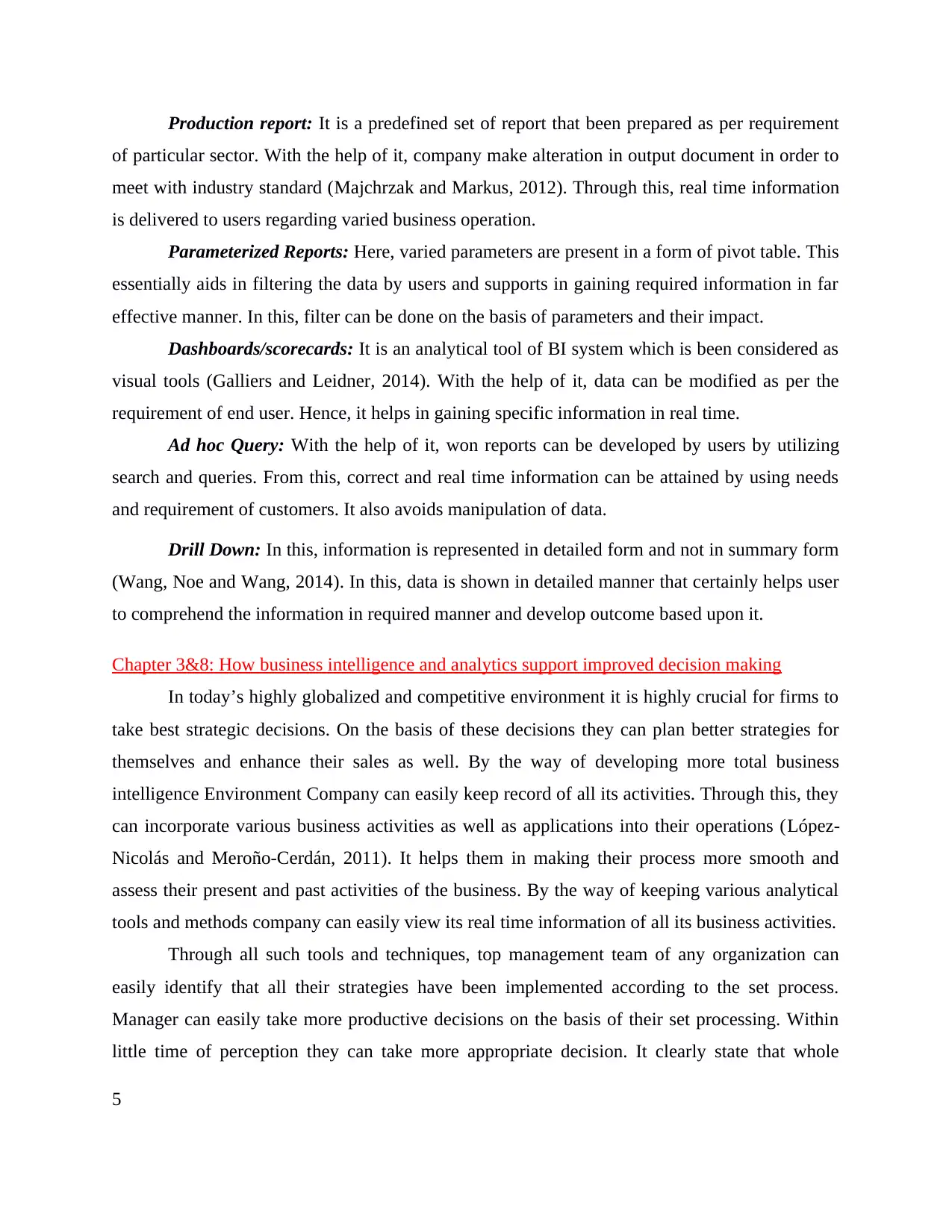
Production report: It is a predefined set of report that been prepared as per requirement
of particular sector. With the help of it, company make alteration in output document in order to
meet with industry standard (Majchrzak and Markus, 2012). Through this, real time information
is delivered to users regarding varied business operation.
Parameterized Reports: Here, varied parameters are present in a form of pivot table. This
essentially aids in filtering the data by users and supports in gaining required information in far
effective manner. In this, filter can be done on the basis of parameters and their impact.
Dashboards/scorecards: It is an analytical tool of BI system which is been considered as
visual tools (Galliers and Leidner, 2014). With the help of it, data can be modified as per the
requirement of end user. Hence, it helps in gaining specific information in real time.
Ad hoc Query: With the help of it, won reports can be developed by users by utilizing
search and queries. From this, correct and real time information can be attained by using needs
and requirement of customers. It also avoids manipulation of data.
Drill Down: In this, information is represented in detailed form and not in summary form
(Wang, Noe and Wang, 2014). In this, data is shown in detailed manner that certainly helps user
to comprehend the information in required manner and develop outcome based upon it.
Chapter 3&8: How business intelligence and analytics support improved decision making
In today’s highly globalized and competitive environment it is highly crucial for firms to
take best strategic decisions. On the basis of these decisions they can plan better strategies for
themselves and enhance their sales as well. By the way of developing more total business
intelligence Environment Company can easily keep record of all its activities. Through this, they
can incorporate various business activities as well as applications into their operations (López-
Nicolás and Meroño-Cerdán, 2011). It helps them in making their process more smooth and
assess their present and past activities of the business. By the way of keeping various analytical
tools and methods company can easily view its real time information of all its business activities.
Through all such tools and techniques, top management team of any organization can
easily identify that all their strategies have been implemented according to the set process.
Manager can easily take more productive decisions on the basis of their set processing. Within
little time of perception they can take more appropriate decision. It clearly state that whole
5
of particular sector. With the help of it, company make alteration in output document in order to
meet with industry standard (Majchrzak and Markus, 2012). Through this, real time information
is delivered to users regarding varied business operation.
Parameterized Reports: Here, varied parameters are present in a form of pivot table. This
essentially aids in filtering the data by users and supports in gaining required information in far
effective manner. In this, filter can be done on the basis of parameters and their impact.
Dashboards/scorecards: It is an analytical tool of BI system which is been considered as
visual tools (Galliers and Leidner, 2014). With the help of it, data can be modified as per the
requirement of end user. Hence, it helps in gaining specific information in real time.
Ad hoc Query: With the help of it, won reports can be developed by users by utilizing
search and queries. From this, correct and real time information can be attained by using needs
and requirement of customers. It also avoids manipulation of data.
Drill Down: In this, information is represented in detailed form and not in summary form
(Wang, Noe and Wang, 2014). In this, data is shown in detailed manner that certainly helps user
to comprehend the information in required manner and develop outcome based upon it.
Chapter 3&8: How business intelligence and analytics support improved decision making
In today’s highly globalized and competitive environment it is highly crucial for firms to
take best strategic decisions. On the basis of these decisions they can plan better strategies for
themselves and enhance their sales as well. By the way of developing more total business
intelligence Environment Company can easily keep record of all its activities. Through this, they
can incorporate various business activities as well as applications into their operations (López-
Nicolás and Meroño-Cerdán, 2011). It helps them in making their process more smooth and
assess their present and past activities of the business. By the way of keeping various analytical
tools and methods company can easily view its real time information of all its business activities.
Through all such tools and techniques, top management team of any organization can
easily identify that all their strategies have been implemented according to the set process.
Manager can easily take more productive decisions on the basis of their set processing. Within
little time of perception they can take more appropriate decision. It clearly state that whole
5
Paraphrase This Document
Need a fresh take? Get an instant paraphrase of this document with our AI Paraphraser
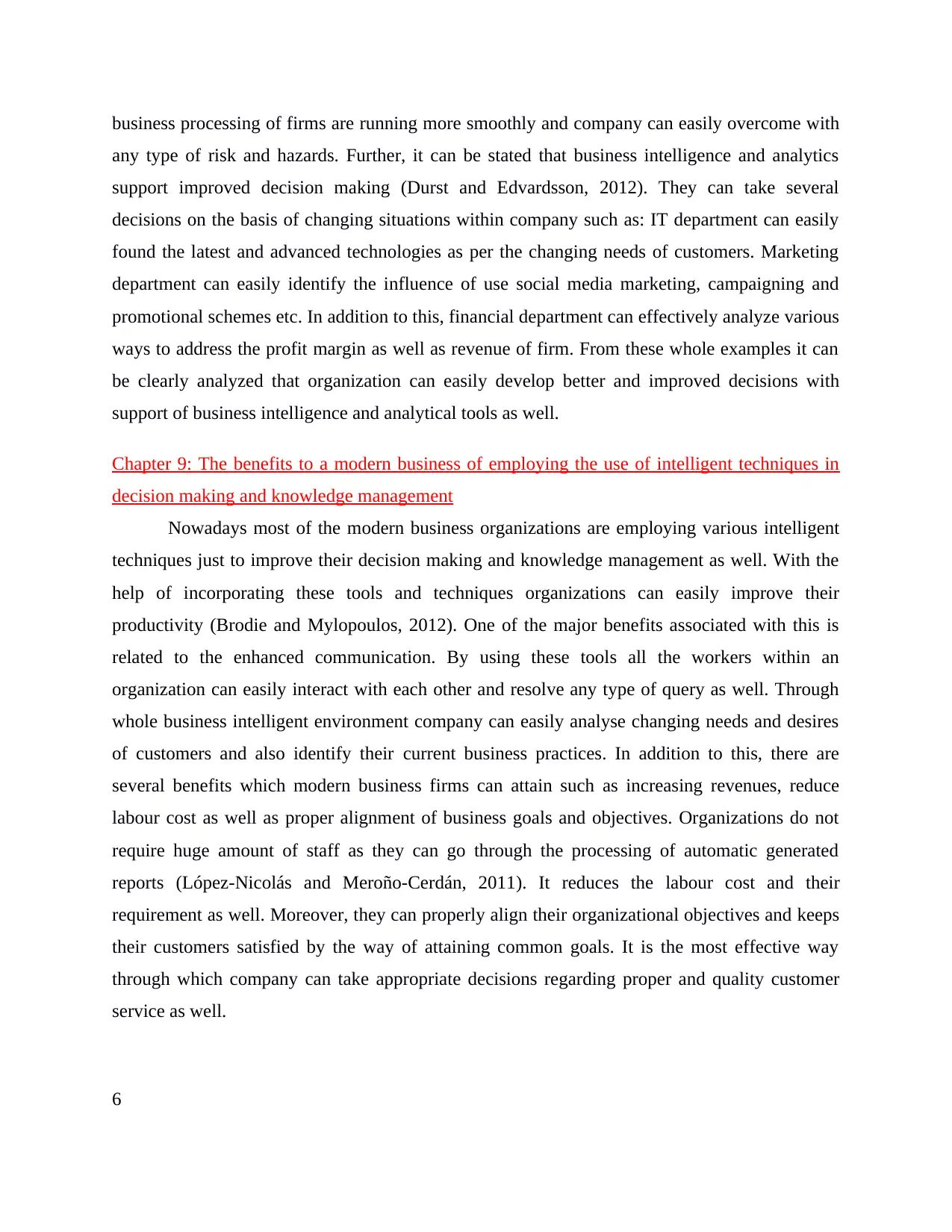
business processing of firms are running more smoothly and company can easily overcome with
any type of risk and hazards. Further, it can be stated that business intelligence and analytics
support improved decision making (Durst and Edvardsson, 2012). They can take several
decisions on the basis of changing situations within company such as: IT department can easily
found the latest and advanced technologies as per the changing needs of customers. Marketing
department can easily identify the influence of use social media marketing, campaigning and
promotional schemes etc. In addition to this, financial department can effectively analyze various
ways to address the profit margin as well as revenue of firm. From these whole examples it can
be clearly analyzed that organization can easily develop better and improved decisions with
support of business intelligence and analytical tools as well.
Chapter 9: The benefits to a modern business of employing the use of intelligent techniques in
decision making and knowledge management
Nowadays most of the modern business organizations are employing various intelligent
techniques just to improve their decision making and knowledge management as well. With the
help of incorporating these tools and techniques organizations can easily improve their
productivity (Brodie and Mylopoulos, 2012). One of the major benefits associated with this is
related to the enhanced communication. By using these tools all the workers within an
organization can easily interact with each other and resolve any type of query as well. Through
whole business intelligent environment company can easily analyse changing needs and desires
of customers and also identify their current business practices. In addition to this, there are
several benefits which modern business firms can attain such as increasing revenues, reduce
labour cost as well as proper alignment of business goals and objectives. Organizations do not
require huge amount of staff as they can go through the processing of automatic generated
reports (López-Nicolás and Meroño-Cerdán, 2011). It reduces the labour cost and their
requirement as well. Moreover, they can properly align their organizational objectives and keeps
their customers satisfied by the way of attaining common goals. It is the most effective way
through which company can take appropriate decisions regarding proper and quality customer
service as well.
6
any type of risk and hazards. Further, it can be stated that business intelligence and analytics
support improved decision making (Durst and Edvardsson, 2012). They can take several
decisions on the basis of changing situations within company such as: IT department can easily
found the latest and advanced technologies as per the changing needs of customers. Marketing
department can easily identify the influence of use social media marketing, campaigning and
promotional schemes etc. In addition to this, financial department can effectively analyze various
ways to address the profit margin as well as revenue of firm. From these whole examples it can
be clearly analyzed that organization can easily develop better and improved decisions with
support of business intelligence and analytical tools as well.
Chapter 9: The benefits to a modern business of employing the use of intelligent techniques in
decision making and knowledge management
Nowadays most of the modern business organizations are employing various intelligent
techniques just to improve their decision making and knowledge management as well. With the
help of incorporating these tools and techniques organizations can easily improve their
productivity (Brodie and Mylopoulos, 2012). One of the major benefits associated with this is
related to the enhanced communication. By using these tools all the workers within an
organization can easily interact with each other and resolve any type of query as well. Through
whole business intelligent environment company can easily analyse changing needs and desires
of customers and also identify their current business practices. In addition to this, there are
several benefits which modern business firms can attain such as increasing revenues, reduce
labour cost as well as proper alignment of business goals and objectives. Organizations do not
require huge amount of staff as they can go through the processing of automatic generated
reports (López-Nicolás and Meroño-Cerdán, 2011). It reduces the labour cost and their
requirement as well. Moreover, they can properly align their organizational objectives and keeps
their customers satisfied by the way of attaining common goals. It is the most effective way
through which company can take appropriate decisions regarding proper and quality customer
service as well.
6
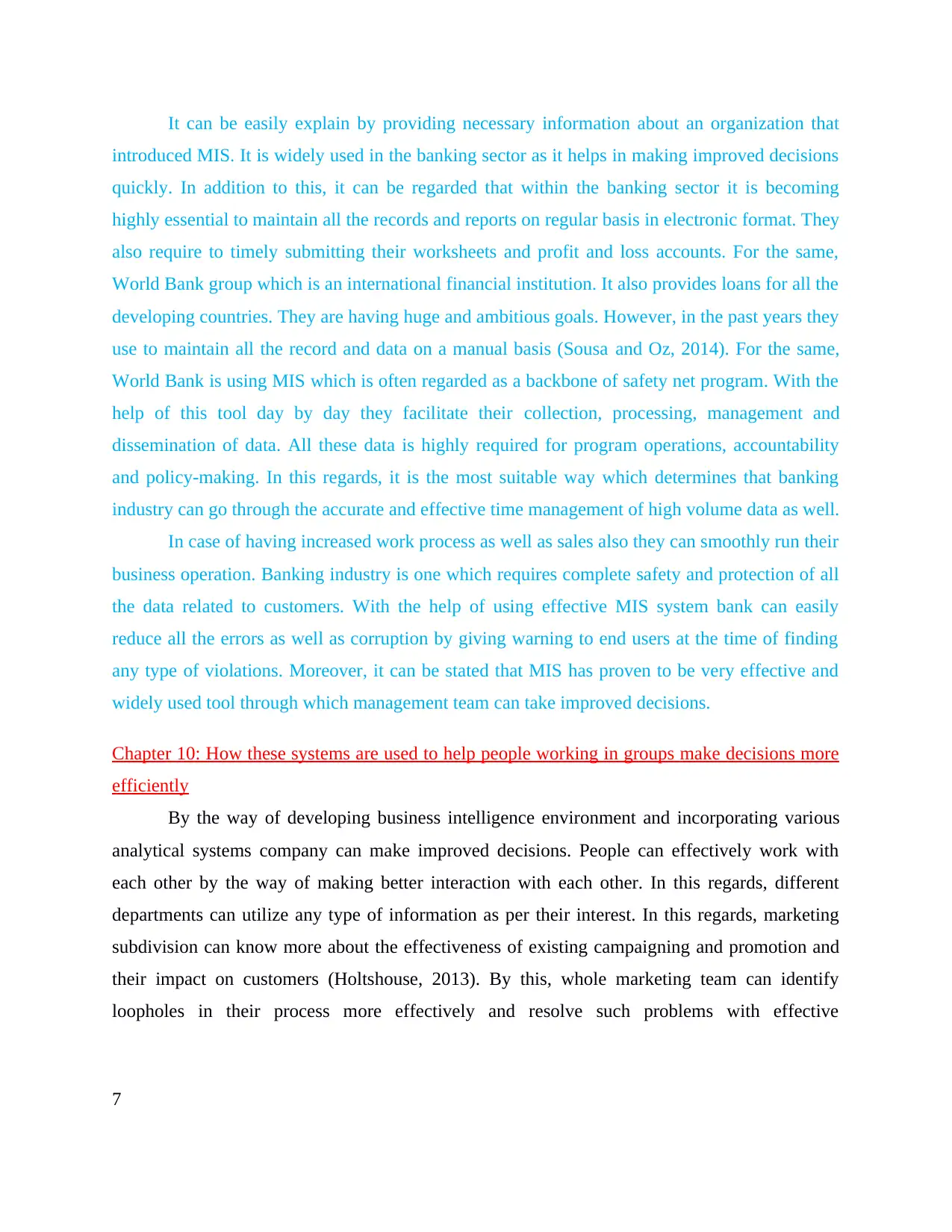
It can be easily explain by providing necessary information about an organization that
introduced MIS. It is widely used in the banking sector as it helps in making improved decisions
quickly. In addition to this, it can be regarded that within the banking sector it is becoming
highly essential to maintain all the records and reports on regular basis in electronic format. They
also require to timely submitting their worksheets and profit and loss accounts. For the same,
World Bank group which is an international financial institution. It also provides loans for all the
developing countries. They are having huge and ambitious goals. However, in the past years they
use to maintain all the record and data on a manual basis (Sousa and Oz, 2014). For the same,
World Bank is using MIS which is often regarded as a backbone of safety net program. With the
help of this tool day by day they facilitate their collection, processing, management and
dissemination of data. All these data is highly required for program operations, accountability
and policy-making. In this regards, it is the most suitable way which determines that banking
industry can go through the accurate and effective time management of high volume data as well.
In case of having increased work process as well as sales also they can smoothly run their
business operation. Banking industry is one which requires complete safety and protection of all
the data related to customers. With the help of using effective MIS system bank can easily
reduce all the errors as well as corruption by giving warning to end users at the time of finding
any type of violations. Moreover, it can be stated that MIS has proven to be very effective and
widely used tool through which management team can take improved decisions.
Chapter 10: How these systems are used to help people working in groups make decisions more
efficiently
By the way of developing business intelligence environment and incorporating various
analytical systems company can make improved decisions. People can effectively work with
each other by the way of making better interaction with each other. In this regards, different
departments can utilize any type of information as per their interest. In this regards, marketing
subdivision can know more about the effectiveness of existing campaigning and promotion and
their impact on customers (Holtshouse, 2013). By this, whole marketing team can identify
loopholes in their process more effectively and resolve such problems with effective
7
introduced MIS. It is widely used in the banking sector as it helps in making improved decisions
quickly. In addition to this, it can be regarded that within the banking sector it is becoming
highly essential to maintain all the records and reports on regular basis in electronic format. They
also require to timely submitting their worksheets and profit and loss accounts. For the same,
World Bank group which is an international financial institution. It also provides loans for all the
developing countries. They are having huge and ambitious goals. However, in the past years they
use to maintain all the record and data on a manual basis (Sousa and Oz, 2014). For the same,
World Bank is using MIS which is often regarded as a backbone of safety net program. With the
help of this tool day by day they facilitate their collection, processing, management and
dissemination of data. All these data is highly required for program operations, accountability
and policy-making. In this regards, it is the most suitable way which determines that banking
industry can go through the accurate and effective time management of high volume data as well.
In case of having increased work process as well as sales also they can smoothly run their
business operation. Banking industry is one which requires complete safety and protection of all
the data related to customers. With the help of using effective MIS system bank can easily
reduce all the errors as well as corruption by giving warning to end users at the time of finding
any type of violations. Moreover, it can be stated that MIS has proven to be very effective and
widely used tool through which management team can take improved decisions.
Chapter 10: How these systems are used to help people working in groups make decisions more
efficiently
By the way of developing business intelligence environment and incorporating various
analytical systems company can make improved decisions. People can effectively work with
each other by the way of making better interaction with each other. In this regards, different
departments can utilize any type of information as per their interest. In this regards, marketing
subdivision can know more about the effectiveness of existing campaigning and promotion and
their impact on customers (Holtshouse, 2013). By this, whole marketing team can identify
loopholes in their process more effectively and resolve such problems with effective
7
⊘ This is a preview!⊘
Do you want full access?
Subscribe today to unlock all pages.

Trusted by 1+ million students worldwide
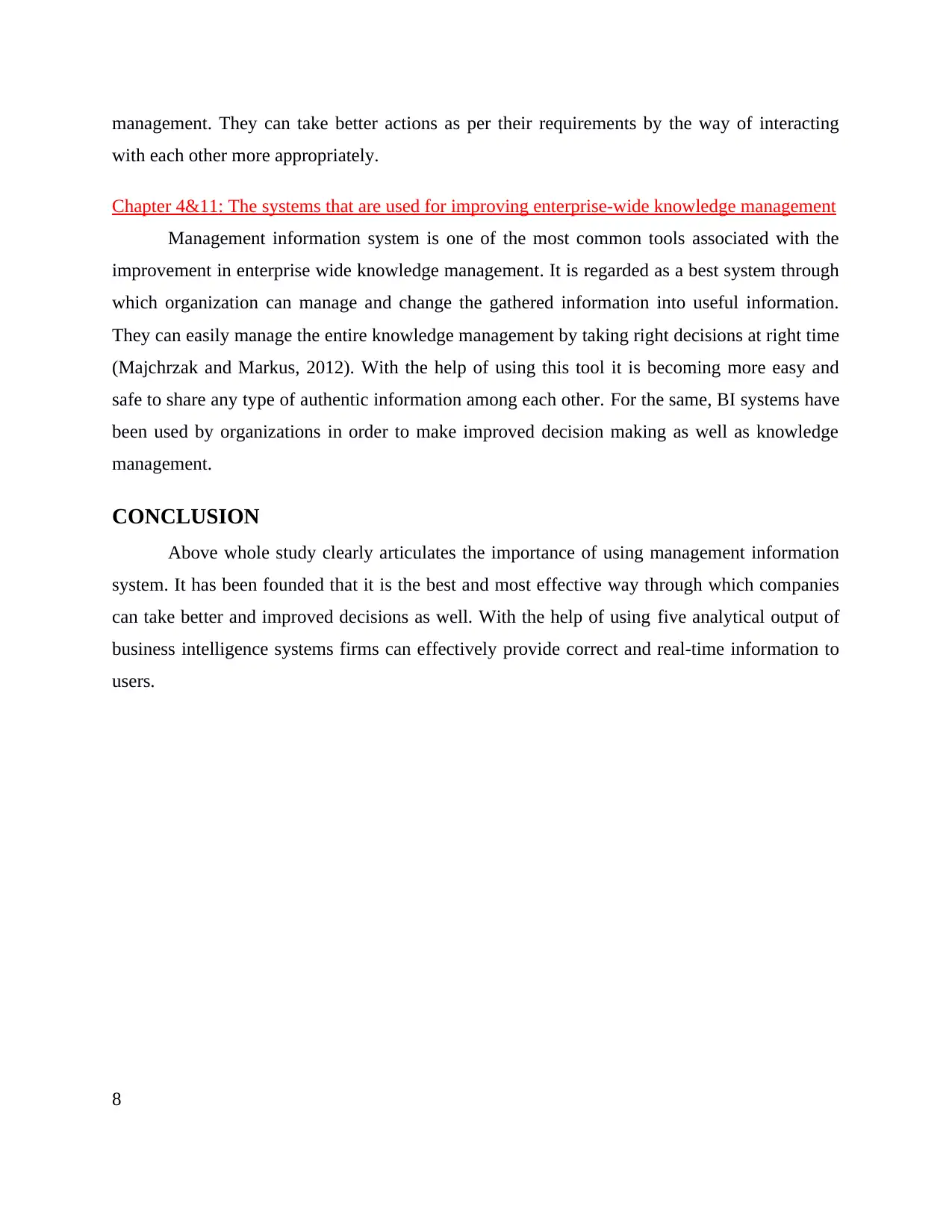
management. They can take better actions as per their requirements by the way of interacting
with each other more appropriately.
Chapter 4&11: The systems that are used for improving enterprise-wide knowledge management
Management information system is one of the most common tools associated with the
improvement in enterprise wide knowledge management. It is regarded as a best system through
which organization can manage and change the gathered information into useful information.
They can easily manage the entire knowledge management by taking right decisions at right time
(Majchrzak and Markus, 2012). With the help of using this tool it is becoming more easy and
safe to share any type of authentic information among each other. For the same, BI systems have
been used by organizations in order to make improved decision making as well as knowledge
management.
CONCLUSION
Above whole study clearly articulates the importance of using management information
system. It has been founded that it is the best and most effective way through which companies
can take better and improved decisions as well. With the help of using five analytical output of
business intelligence systems firms can effectively provide correct and real-time information to
users.
8
with each other more appropriately.
Chapter 4&11: The systems that are used for improving enterprise-wide knowledge management
Management information system is one of the most common tools associated with the
improvement in enterprise wide knowledge management. It is regarded as a best system through
which organization can manage and change the gathered information into useful information.
They can easily manage the entire knowledge management by taking right decisions at right time
(Majchrzak and Markus, 2012). With the help of using this tool it is becoming more easy and
safe to share any type of authentic information among each other. For the same, BI systems have
been used by organizations in order to make improved decision making as well as knowledge
management.
CONCLUSION
Above whole study clearly articulates the importance of using management information
system. It has been founded that it is the best and most effective way through which companies
can take better and improved decisions as well. With the help of using five analytical output of
business intelligence systems firms can effectively provide correct and real-time information to
users.
8
Paraphrase This Document
Need a fresh take? Get an instant paraphrase of this document with our AI Paraphraser
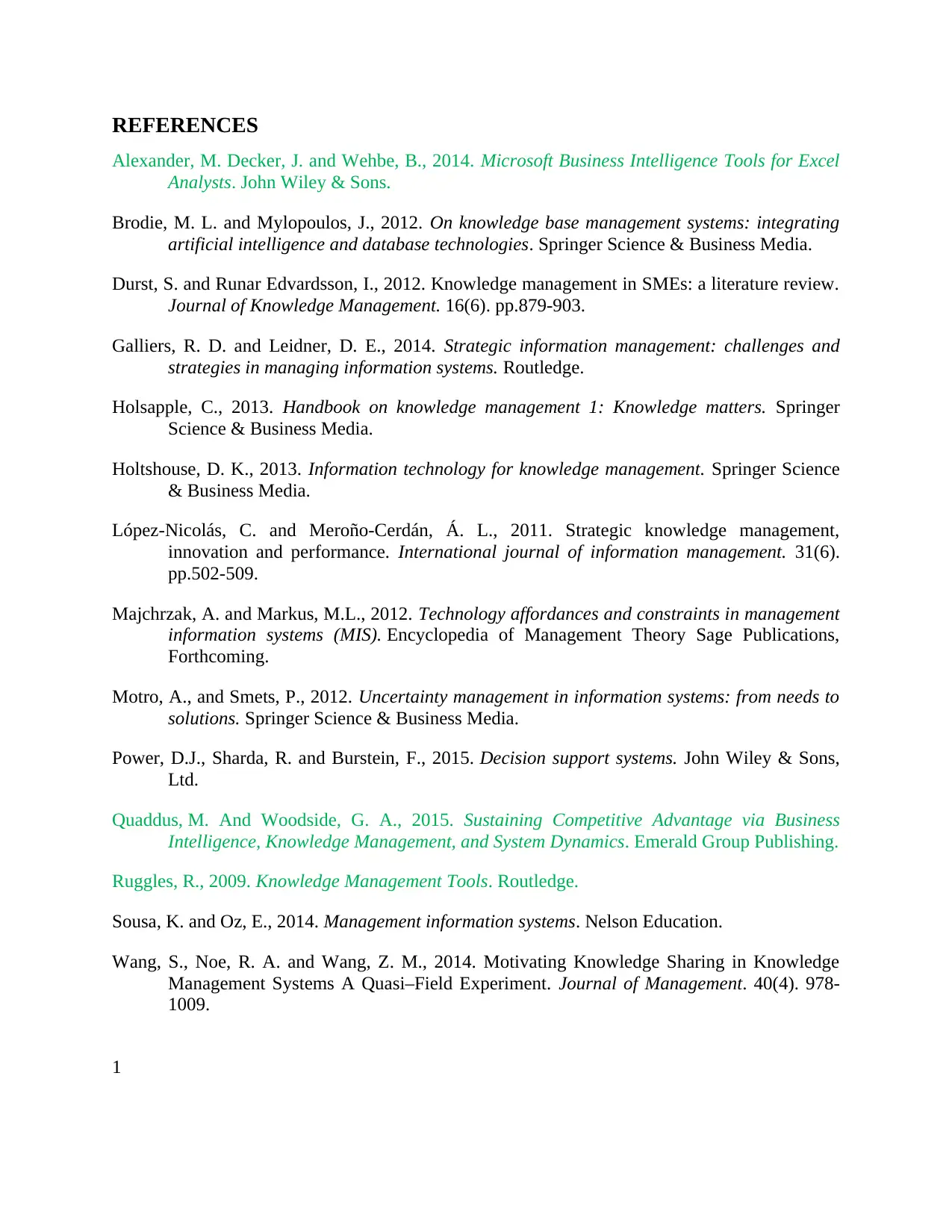
REFERENCES
Alexander, M. Decker, J. and Wehbe, B., 2014. Microsoft Business Intelligence Tools for Excel
Analysts. John Wiley & Sons.
Brodie, M. L. and Mylopoulos, J., 2012. On knowledge base management systems: integrating
artificial intelligence and database technologies. Springer Science & Business Media.
Durst, S. and Runar Edvardsson, I., 2012. Knowledge management in SMEs: a literature review.
Journal of Knowledge Management. 16(6). pp.879-903.
Galliers, R. D. and Leidner, D. E., 2014. Strategic information management: challenges and
strategies in managing information systems. Routledge.
Holsapple, C., 2013. Handbook on knowledge management 1: Knowledge matters. Springer
Science & Business Media.
Holtshouse, D. K., 2013. Information technology for knowledge management. Springer Science
& Business Media.
López-Nicolás, C. and Meroño-Cerdán, Á. L., 2011. Strategic knowledge management,
innovation and performance. International journal of information management. 31(6).
pp.502-509.
Majchrzak, A. and Markus, M.L., 2012. Technology affordances and constraints in management
information systems (MIS). Encyclopedia of Management Theory Sage Publications,
Forthcoming.
Motro, A., and Smets, P., 2012. Uncertainty management in information systems: from needs to
solutions. Springer Science & Business Media.
Power, D.J., Sharda, R. and Burstein, F., 2015. Decision support systems. John Wiley & Sons,
Ltd.
Quaddus, M. And Woodside, G. A., 2015. Sustaining Competitive Advantage via Business
Intelligence, Knowledge Management, and System Dynamics. Emerald Group Publishing.
Ruggles, R., 2009. Knowledge Management Tools. Routledge.
Sousa, K. and Oz, E., 2014. Management information systems. Nelson Education.
Wang, S., Noe, R. A. and Wang, Z. M., 2014. Motivating Knowledge Sharing in Knowledge
Management Systems A Quasi–Field Experiment. Journal of Management. 40(4). 978-
1009.
1
Alexander, M. Decker, J. and Wehbe, B., 2014. Microsoft Business Intelligence Tools for Excel
Analysts. John Wiley & Sons.
Brodie, M. L. and Mylopoulos, J., 2012. On knowledge base management systems: integrating
artificial intelligence and database technologies. Springer Science & Business Media.
Durst, S. and Runar Edvardsson, I., 2012. Knowledge management in SMEs: a literature review.
Journal of Knowledge Management. 16(6). pp.879-903.
Galliers, R. D. and Leidner, D. E., 2014. Strategic information management: challenges and
strategies in managing information systems. Routledge.
Holsapple, C., 2013. Handbook on knowledge management 1: Knowledge matters. Springer
Science & Business Media.
Holtshouse, D. K., 2013. Information technology for knowledge management. Springer Science
& Business Media.
López-Nicolás, C. and Meroño-Cerdán, Á. L., 2011. Strategic knowledge management,
innovation and performance. International journal of information management. 31(6).
pp.502-509.
Majchrzak, A. and Markus, M.L., 2012. Technology affordances and constraints in management
information systems (MIS). Encyclopedia of Management Theory Sage Publications,
Forthcoming.
Motro, A., and Smets, P., 2012. Uncertainty management in information systems: from needs to
solutions. Springer Science & Business Media.
Power, D.J., Sharda, R. and Burstein, F., 2015. Decision support systems. John Wiley & Sons,
Ltd.
Quaddus, M. And Woodside, G. A., 2015. Sustaining Competitive Advantage via Business
Intelligence, Knowledge Management, and System Dynamics. Emerald Group Publishing.
Ruggles, R., 2009. Knowledge Management Tools. Routledge.
Sousa, K. and Oz, E., 2014. Management information systems. Nelson Education.
Wang, S., Noe, R. A. and Wang, Z. M., 2014. Motivating Knowledge Sharing in Knowledge
Management Systems A Quasi–Field Experiment. Journal of Management. 40(4). 978-
1009.
1

Wang, Y., Meister, D. B. and Gray, P. H., 2013. Social influence and knowledge management
systems use: Evidence from panel data. Mis Quarterly. 37(1). pp.299-313.
2
systems use: Evidence from panel data. Mis Quarterly. 37(1). pp.299-313.
2
⊘ This is a preview!⊘
Do you want full access?
Subscribe today to unlock all pages.

Trusted by 1+ million students worldwide
1 out of 12
Related Documents
Your All-in-One AI-Powered Toolkit for Academic Success.
+13062052269
info@desklib.com
Available 24*7 on WhatsApp / Email
![[object Object]](/_next/static/media/star-bottom.7253800d.svg)
Unlock your academic potential
Copyright © 2020–2025 A2Z Services. All Rights Reserved. Developed and managed by ZUCOL.




